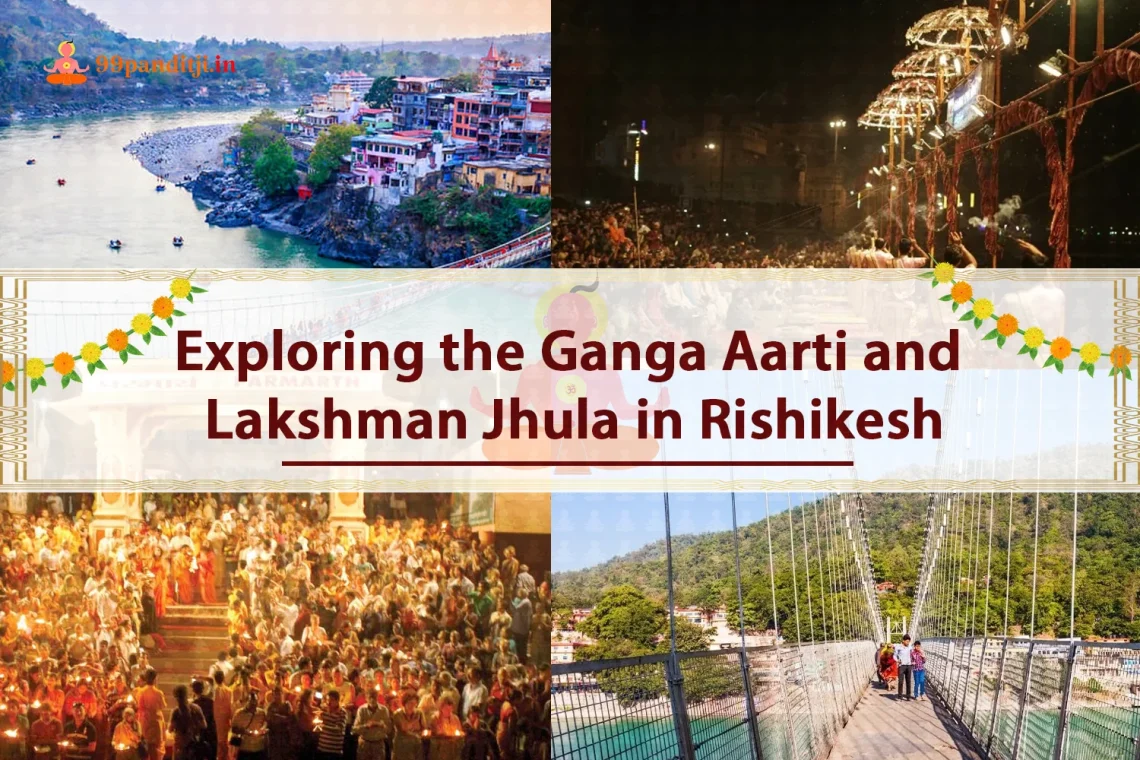Visiting Rishikesh is not complete without seeing the religious Ganga arti and Lakshman jhula here. In the crowded town of Rishikesh, the serene banks of the holy river Ganga are popular for their divine arti. Following the old tradition that attracts visitors around the globe. Ganga arti is a religious custom that worships the river goddess, an integral part of the Rishikesh cultural fabric.
On the other hand, Lakshman jhula, another sight of Rishikesh, is not just a bridge. This is a sign of the region’s rich heritage and spiritual importance. Traversing 450 feet around the river and standing 70 feet above the river, the iconic architecture bridges Tapovan and Jonk villages.
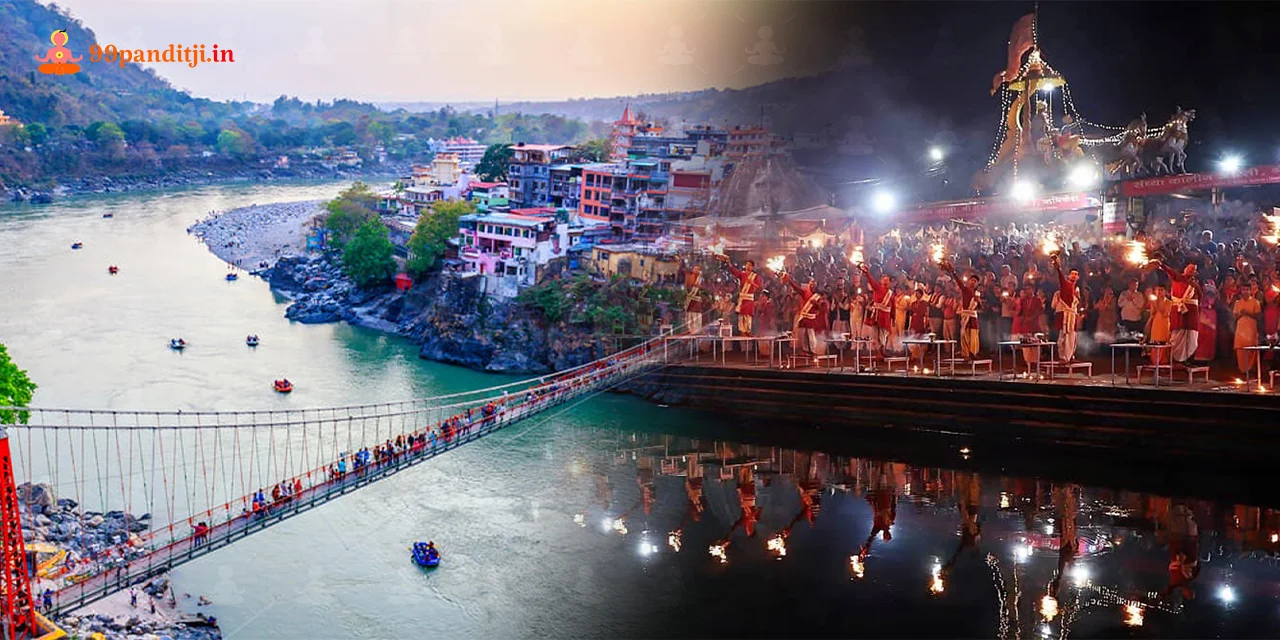
Apart from practical motives, Lakshman jhula provides scenic views and opens the door to many spiritual and adventurous moves. In this post, we will walk you through spiritual practice. Also, revealing the best Ganga Arti experience and Lakshman jhula in Rishikesh, along with trip planning information.
Understanding Ganga Arti in Rishikesh
A spiritual ceremony performed in Rishikesh is Ganga arti to honor the river goddess. The ritual is of immense importance in Hinduism. It is connected to centuries-old customs, organized on a daily basis at many ghats along the Ganga River in Rishikesh.
It shows the reverence and gratitude to the holy river of devotees. The river is known to cleanse the sins and bless the one who comes in contact with its waters. Visit Parmarth Niketan Ashram, which is located next to the sacred Ganges River in Rishikesh, to witness the well-known Ganga Aarti ceremony.
You can visit Triveni Ghat for an aarti, as it is renowned for its aesthetic beauty and spiritual significance. This daily ritual, along with the large and revered aartis at other ghats, offers a profound experience. In order to receive blessings for spiritual advancement and purification, devotees gather to worship Goddess Ganga.
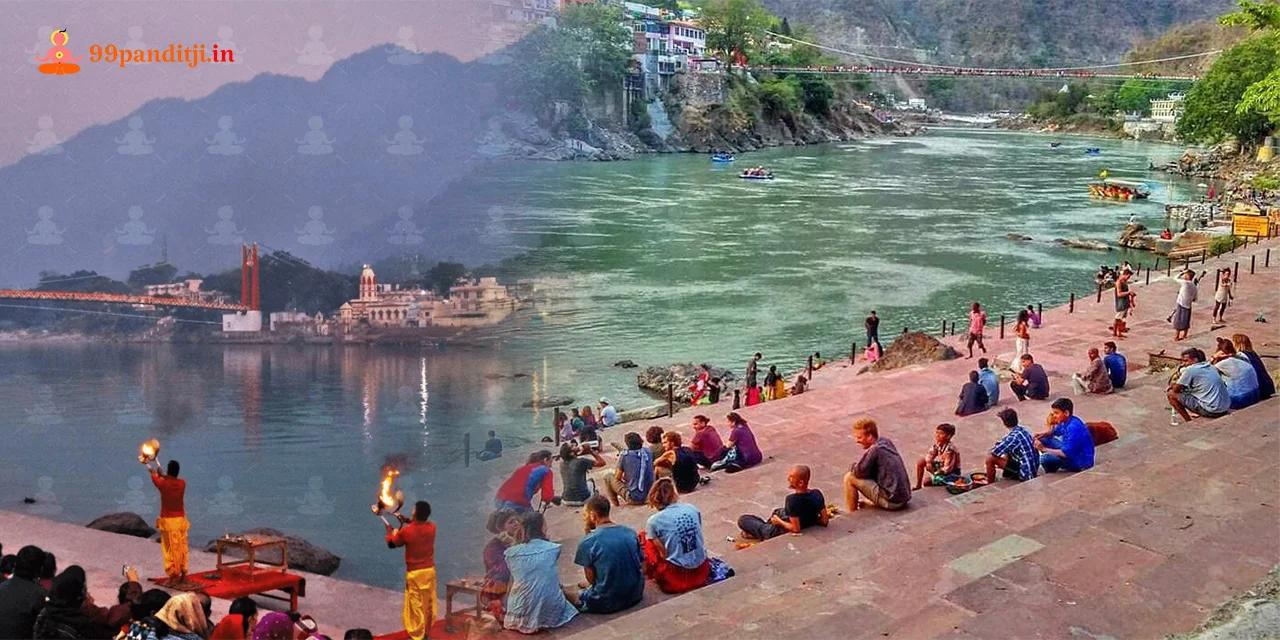
Priests use incense, flowers, and lit lamps to perform elaborate ceremonies during Ganga Aarti. It creates a mystical ambiance full of hymns and religious chants. As the sun goes down, innumerable lamps light up the river, illustrating how people and nature are united wonderfully. As traveling to Uttarakhand, take in the heart-stirring Ganga Aarti, which combines spirituality with scenic marvels.
Historical Significance & Legend of Lakshman Jhula
Lakshman jhula is not only a structural marvel but a bridge connected with history and mythological essence. As per the local legend, Lakshman (younger brother of lord Ram) travels the river Ganga using a jute rope at this place. Hence, mythological engagement adds a bridge to its name and adds a layer of religiousness to its presence.
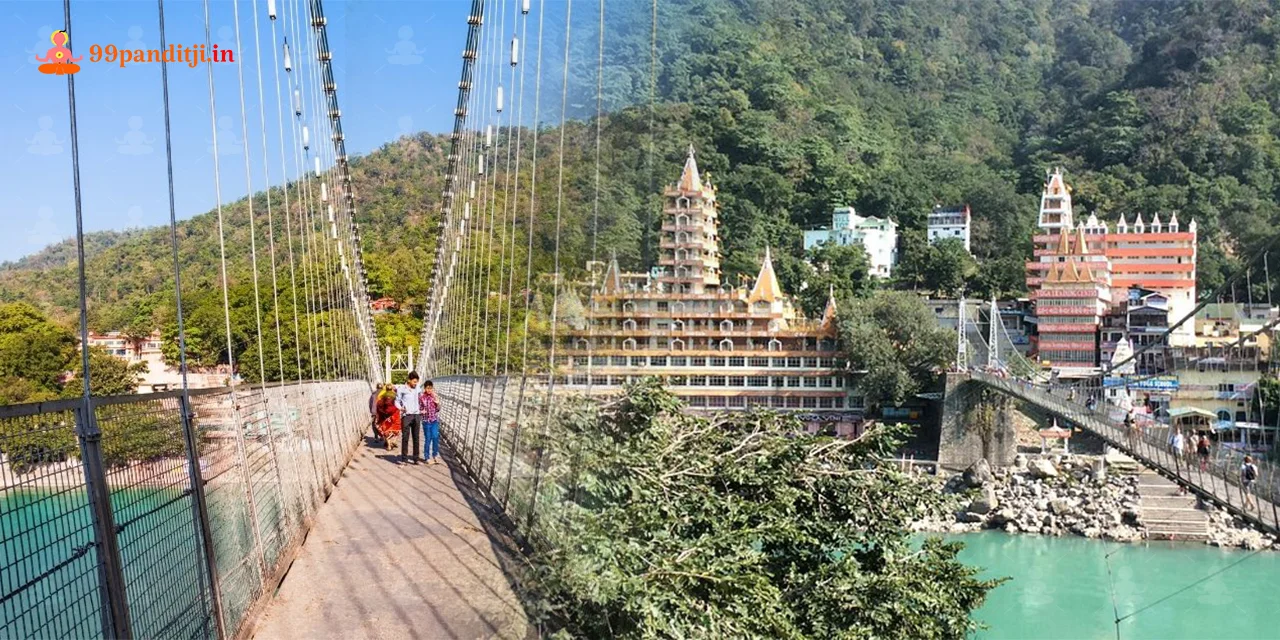
The original bridge was developed in 1889, first made of jute ropes, and operated as a complex crossing point for devotees and locals. However, due to wear and tear, the bridge was redeveloped with iron cables in 1939. It gives safer and more durable architecture. Presently, the bridge has been straightened with steel threads to guarantee longevity and safety for walkers.
Explore the Ganga Arti at the Divine Land of Rishikesh
1. Ganga arti at Parmarth Niketan Ashram
Parmarth Niketan Ashram, rooted at the banks of the Ganga River, jumbled with devotees and pilgrims to experience Ganga arti. The ashram is a destination where one can achieve and perform Vedic knowledge. Vedic pandits perform the ganga arti as well as the children. Maha arti starts with Vedas chanting along with prayers to Agni, the god of fire.
As said, the fire builds positivity between people and the environment. You can reach the ashram by foot, car, or other means of transport. This is around 500 meters from Ram Jhula and 15km from Haridwar.
Timing – During sunset
Unique features – Mesmerizing customs, soul-stirring mantras, and a serene environment.
2. Ganga arti at Triveni Ghat
To take a holy bath, Triveni Ghat is considered the most revered place in Rishikesh. Many travelers take a dip in the events of Ganga Dussehra, Ekadashi, and Purnima. The place is known for scenic views of sunrise and sunset. In the morning and evening, maha arti is performed by pandits. A lot of people sit on the banks of the river and enjoy the cool air with positivity.
Here, the chanting of bhajans, bell ringing, mantra chanting, and priests holding big fire bowls in their palms mark the beginning of the aarti. Every night, the Ghat illuminates during Maha Aarti. People who bathe in this sacred river cleanse their souls, wash away their sins, and find redemption after death.
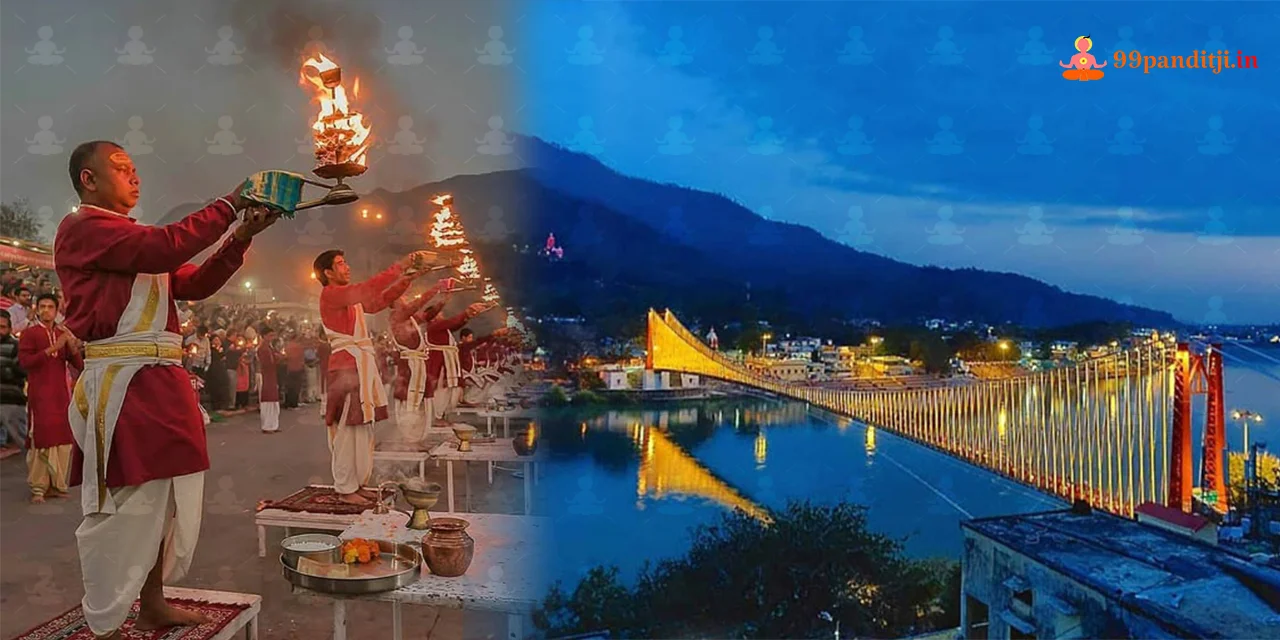
Triveni Ghat is only 1 km from the Rishikesh Bus Stand and 10 km from Haridwar; you can get there by bus or car.
Timing – Perform every evening at twilight
Unique features – Insights into hindu rituals in the vibrant ambiance of the ghat.
Key Historical Points of Lakshman Jhula
- First development: The bridge was initially developed in 1889 through jute ropes. This essential development aided the local people and visitors who often visit the area.
- Redevelopment: Identifying the need for more durable construction, the bridge was redeveloped in 1939 using iron cables. The change not only ensures higher safety but even increased foot traffic.
- Modern support: To adhere to modern safety standards and provide longevity, steel cables were added in past years. These changes ensure the bridge can resist the elements and have a stable flow of visitors.

Lakshman jhula’s historical expansion from one rope bridge to its present reliable form. It shows technological reinforcement and the enduring essence of this crossing point in hindu culture.
Places to Visit Near Triveni Ghat & Lakshman Jhula
The town of Rishikesh is home to incredible landmarks and sightseeing, which will make your visit memorable. Here are a few places to visit near Triveni Ghat & Lakshman jhula:
- Ram jhula – An iconic bridge that links two parts of Rishikesh. Like Lakshman Jiula, it is packed with shops, temples, and cafes.
- Parmarth Niketan Ashram – Nestled near the ghats, it offers yoga, meditation, and religious learning—one of the largest ashrams and ideal for spiritual followers in Rishikesh.
- Beatles ashram – Discover the abandoned ashram that attained popularity when the Beatles came to India in the 1960s—currently a graffiti-filled travel spot with a unique ambiance.
- Neer Garh waterfall – Perfect for nature lovers, a short trek to experience the lovely waterfall and is good for feeling a refreshing break from bustling life.
- Tera Manzil temple (Trimbakeshwar temple) – A short walk from Lakshman jhula, a 13-story temple must be visited. It’s devoted to the hindu lord and gives a panoramic view of Rishikesh and the holy river from the top floor.
Things to do at Lakshman Jhula and Triveni Ghat
Experiencing the divine ganga arti includes other activities to make your trip to Triveni Ghat and Lakshman jhula more memorable.
- Take a holy dip in the Ganga – It’s believed that bathing in the holy river at Triveni Ghat cleanses the soul and body. Remove your sins and start your day by immersing yourself in the sacred river before Arti.
- Yoga and meditation – Rishikesh is known to be the yoga capital, and various ashrams or centers near Triveni ghat give yoga sessions. It’s an amazing way to calm and relax your mind.
- Explore temples – Many temples in Rishikesh are located near Triveni ghat like Raghunath and Bharat mandir. Visiting the temple gives a touch of history and devotion to the trip.
- Boat ride on the Ganges – A calming ride on a boat along the holy river during sunset is a beautiful thing. You can visit the riverside temples and ghats to catch the spiritual beauty of Rishikesh.
- Take part in spiritual discourses – A number of ashrams in Rishikesh give religious lessons and discourses on Hinduism. The right option is to know more about Indian culture.
Best Time to Visit Ganga Arti and Lakshman Jhula
If you’re planning to explore Ganga Arti and Lakshman jhula in Rishikesh, check the right time and weather. The best time to visit Lakshman jhula is between September and June. At this time, weather conditions are pleasant and good to perform many activities like rafting, sightseeing, etc.
- Summer (March to June): Generous but tolerable, mainly in the mornings and evenings.
- Winter (November to February): Relaxed and cozy, with periodic chilly evenings. This is the ideal time for religious and adventure sports.
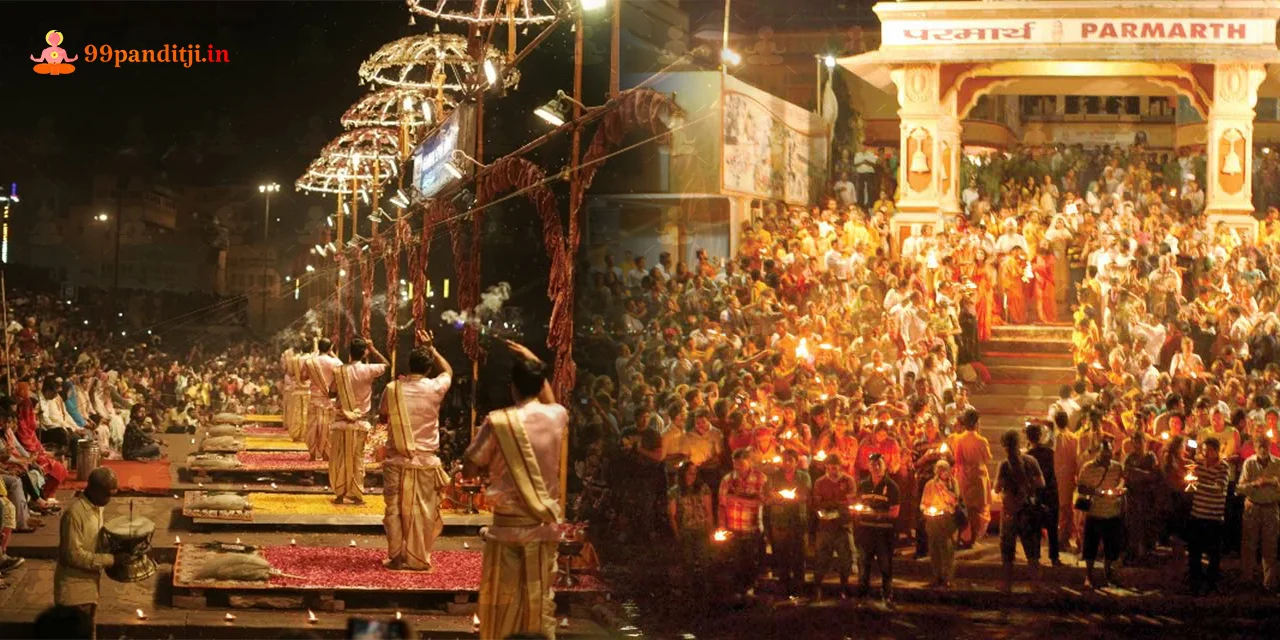
Planning trips in the winter months allows travelers to relish nearby strolling trails and river rafting. You can pick to see Ganga Arti any time of the year; it opens every day.
- Best Day of the Week: Think of traveling during the weekdays to get less crowds and experience the Ganga Aarti spiritual view.
- Best time of the day: In every morning and evening, Ganga Aarti performs. Yet, experiencing ganga arti in the evening is an amazing experience. The aura at that time is out of the world and the preferred event to see in Rishikesh.
Conclusion
Thus, Ganga arti and Lakshman jhula in Rishikesh are the more ritualistic practices. Rishikesh is a place of divine and soul-stirring experience with an indelible mark on the hearts who witness this. Lakshman Jhula represents Rishikesh’s rich history, architectural brilliance, and religious essence.
Lakshman jhula gives a unique feeling of the significance of Rishikesh, whether you’re a pilgrim, enthusiast, or adventure seeker. May the calm banks of the Ganges bless you with inner serenity, knowledge, and harmony as you set out on this spiritual trip. Let the ageless wisdom of the Ganga lead you on your journey to enlightenment and spiritual awakening, and open your heart to the limitless possibilities that lie ahead in the hallowed region of Rishikesh.
Frequently Asked Questions
Ganga arti is a spiritual ceremony performed in Rishikesh, which is Ganga arti to honor the river goddess.
The mythological importance of Lakshman jhula is that Lakshman (younger brother of lord Ram) travels the river Ganga using a jute rope at this place. It adds the bridge to its name and gives a layer of religiousness to its presence.
Generally, Ganga arti perform during sunset, as the exact timing may differ based on the weather.
The original bridge was developed in 1889, first made of jute ropes, and operated as a complex crossing point for devotees and locals.
Ganga arti is observed at many places in Rishikesh, including Parmarth Niketan ashram, Triveni ghat, and Swarg ashram ghat.

